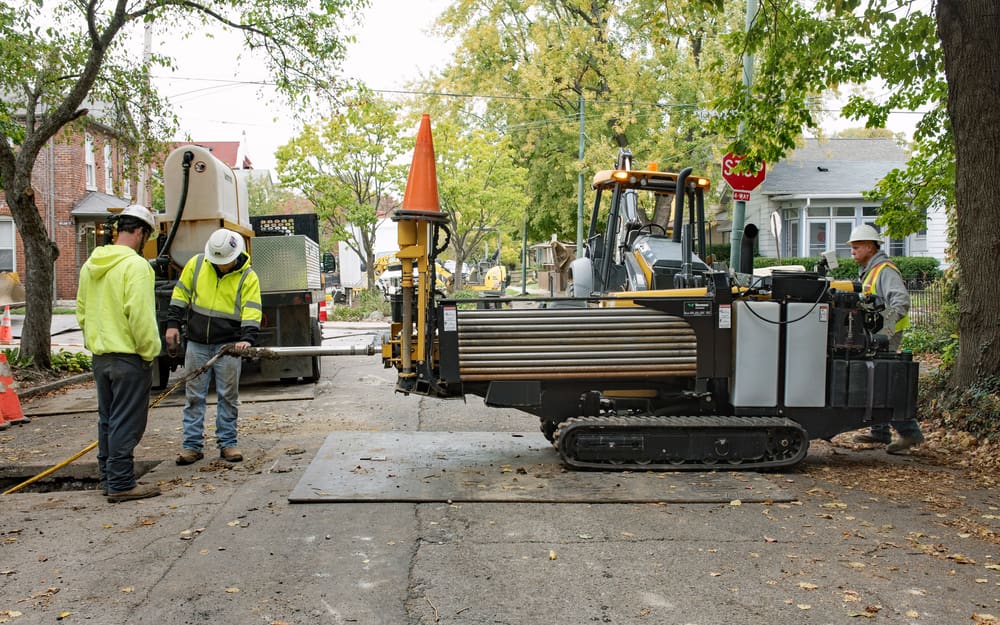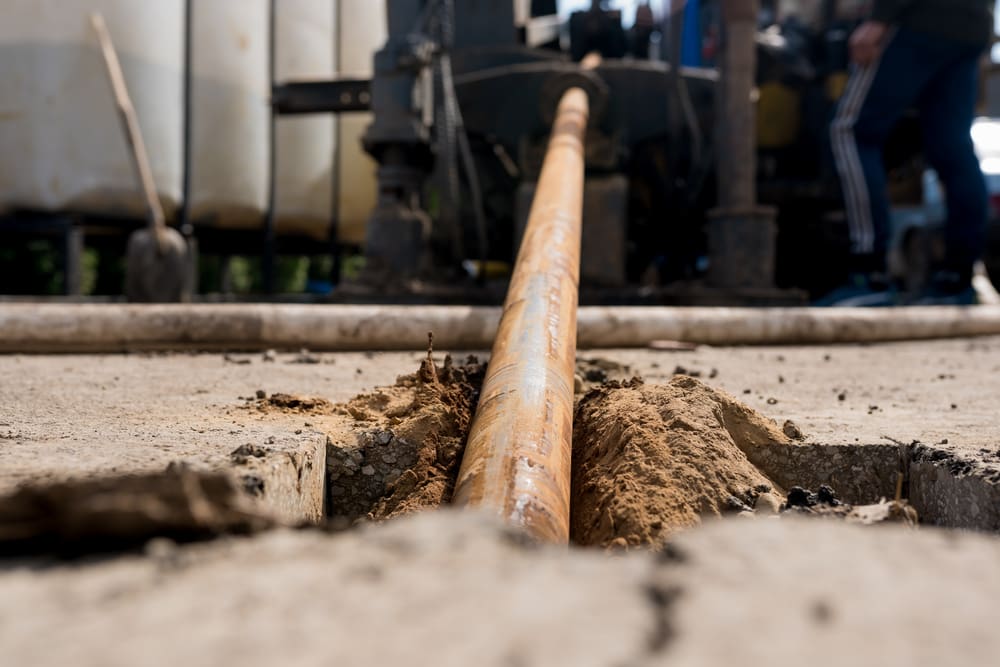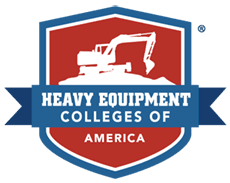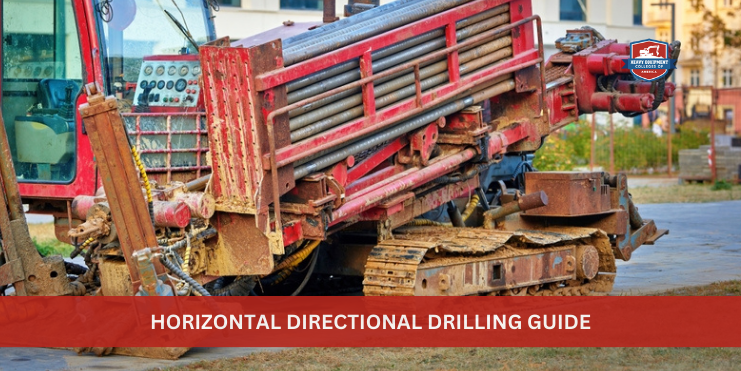When installing underground pipelines near unique land areas, horizontal directional drilling is a surefire way to minimize the negative environmental impact. Let’s take a closer look at why this trenchless technology may be the answer to your next pipeline installation project with our complete Horizontal Directional Drilling Guide.
What Is Horizontal Directional Drilling?
Horizontal directional drilling is a steerable construction drilling method that is utilized in situations where vertical directional drilling is not appropriate: near large bodies of water, congested urban areas, and residential spaces. With the help of a surface-launched drilling rig, operators drill holes horizontally beneath the obstacles sitting on the surface.
Why Is HDD Used?
There are over 1.2 million miles of water pipes surrounded by gas lines, fiber optic cables, and electric/power lines in America. Due to the overcrowding of underground real estate, operators build minimally invasive shallow arcs along predetermined pathways. This limits the threat of impacting existing infrastructure above and below the drill, providing a more cost-effective and environmentally-conscious option.
How Does Horizontal Directional Drilling Work?
There are three main stages in the horizontal directional drilling process: pilot drilling, expanding the drilling point of entry, and pulling the production pipe. Let’s explore each stage in more detail below:

Step 1 - Creating the Pilot Hole
The horizontal directional drill punctures a small diameter hole to create an underground cavity utilizing a drill bit and pipe. Drilling fluid is run through the drill pipe to the drill bit to grind down the soil and rock, cool the drill bit, and carry the cuttings from the hole to the surface.
Step 2 - Pre Reaming
To ensure that the bored hole is large enough to safely install the product lines, a cylindrical rotary cutting tool is pulled back and forth along the pathway while drilling fluid runs through to deepen the hole and remove any remaining rock blocking the passageway.
Step 3 - Pipe Pullback
In the final step, the product pipe is pulled into the drill hole. The drill rod and reamer are attached to a swivel, preventing torsional stress, while the rotating drill string is transferred to the pipe. While the product pipe is pulled into the pre-reamed hole, drilling fluid is pumped throughout the cavity to provide lubrication.
What Is Horizontal Directional Drilling?
What Can I Expect During Directional Drilling?
Directional drilling is often scheduled during daylight hours due to the loud noise created during operation. Construction crews can reduce the noise put off by the drilling with structures designed to reduce and buffer sound waves.
A drilling project’s completion timeline depends on the depth and distance of the underground drill, as well as the drill surface terrain, pipeline diameter, and pace of operations. Completion timelines can range from a few weeks to a few months. While advanced planning can offer estimated completion timelines, unforeseen circumstances can slow or increase drilling progress.
Why Is Horizontal Directional Drilling Important?
- Reduced Costs
Horizontal Directional Drilling is more cost-effective than open-cut drilling. Because HDD is speedier than most drilling systems, the cost of storing equipment is reduced greatly. Due to HDD’s minimally invasive nature, a limited amount of dirt is disturbed, reducing the need to restore surrounding land. Horizontal Directional Drilling also reduces operator qualification requirements, reducing the cost of labor. - Less Disruption
HDD is an environmentally friendly approach to product pipe drilling due to its limited soil displacement and minimal digging length requirement. While a hole is dug at the beginning of the tube, limited to no landscaping is destroyed in the process, reducing the cost of time and money spent on the job cleaning up. - Endurance
HDDs are difficult to damage during the drilling installation process due to their durable material makeup, resulting in longer working performance and positioning accuracy.
Because some pipes are dug under bridges straddling waterways in certain regions, it is possible that the pipe’s lifespan can be reduced by 50% to 75%.
However, because of their accuracy and steerability, HDD makes it increasingly easier to install pipelines underneath bodies of water and concrete infrastructure. - Location is Flexible
HDD is adaptable to many site-specific issues and products. It can be used to dig pipes for water, sewer lines, cable lines, etc., under roadways, culverts, bodies of water, and locations where the pipe needs to bend. HDD makes it possible to lay pipe where it once was thought to be impossible. - Less Soil Contamination
Horizontal Directional Drilling limits the spread of soil contamination above ground, due to its ability to push soil to one side of the hole during drilling.. Additionally, due to the pipes’ long-lasting nature, contaminated soil should not be able to penetrate the pipes, reducing the risk far greater than conventional vertical drilling. - Less Permit Issues
The process of gaining permission to perform HDD in residential and commercial areas is far more streamlined than vertical drilling because the necessary amount of work required and operation-produced debris is similar to traditional drilling practices.

Important Terms To Know
Below is a list of technical terms necessary to understand the process of HDD:
- Back Reamer: a tool used to make the pilot bore larger and to pull the utility line into the bore
- Bore: a hole or underground cavity created during the HDD process
- Casing: a pipe used to stabilize a wide-diameter bore after drilling
- Conduit: the plastic piping used in a bore to protect the low-voltage power lines or protective fiber optic cables
- Drill stem and head: drill bit and metal rod attachment that rotate, transmit drilling fluid to the bore, and excavate rock and soil out of the bore
- Potholing: the process of extracting small test holes from the surface to underground utility lines to expose its location. Hand digging and mechanical digging techniques can be used.
- Reception Pit: the removal of trenchless technology equipment from the installation of underground product pipe, conduit, or cable wires
- Tracking Device: a device used to detect the drill head using an electromagnetic field that tracks the progress of creating a bore during the drilling process
- Vacuum Excavator: the process used to dig potholes with high-pressure water or air that breaks up soil and uncovers utility lines underground
HDD Machine Operator Safety Recommendations
- Ensure that all directions from the operator’s manual are followed.
- Wear correct PPE attire acquired by OSHA regulations.
- Check all fluids and note items needing repair. Make sure to perform all repairs before operation.
- Eliminate clutter and debris from the cab with potential to interfere with safe operation.
- Verify the accuracy of tracking equipment.
- Enter the machine using 3 points of contact without using controls when entering or exiting the operator compartment.
- Do not start the machine until the controls are in proper settings.
- Connect and disconnect drilling system components using approved equipment methods.
Importance of HDD Locator
The HDD locator helps the drill operator see the orientation and location of the drill head while the operator works to place the drill head in the bore. It acts as a metal detector to ensure that the drill head location follows the predetermined pathway while avoiding the existing underground conduits in the process.
Are There Environmental Risks From Horizontal Directional Drilling?
The most cited environmental risks associated with HDD are IRs and the contamination of soil and groundwater due to mud drilling leakage.
How To Become a Certified HDD Operator?
If you’re looking for horizontal directional drilling certification, Heavy Equipment Colleges of America is the perfect place to go. Our HDD programs equip you with hands-on training to secure employment in your chosen industry. Plus, they can be completed in as little as three weeks.
Take the first step to pursuing the future you want by applying to HEC today.





